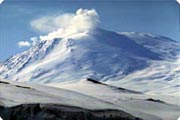
|

|
|
|
Photo: NSF
|
|
|
Mount
Erebus.
|
|
|
|

When you think
of Antarctica, you probably think of glaciers and penguins.
But if you’d visited 200 million years ago, you would
have found lush forests and dinosaurs. What happened?
Scientists
believe that the Earth’s continents—Africa, Eurasia,
Australia, North and South America, and Antarctica—were
once part of a single, giant continent called Pangaea. According
to the theory, the chunk of Pangaea this is now Antarctica
was once at a much balmier latitude. As it drifted toward
the pole, its climate cooled and the forests and wildlife
gradually gave way to ice.
Follow
this link for an
interactive animation
of how scientists think Pangaea broke up. You will need the
Flash
5 Plugin
to view this animation. Or see the
non-Flash
version
.
|
